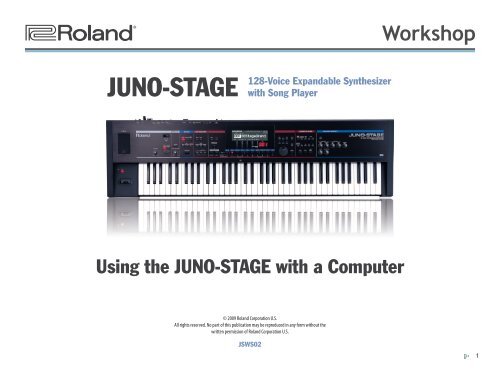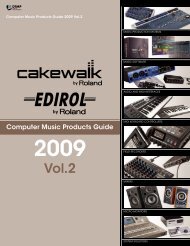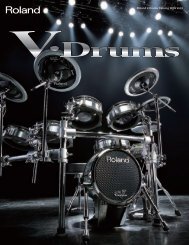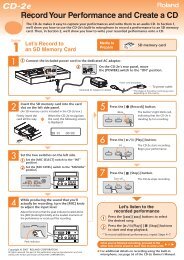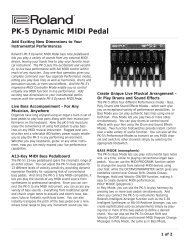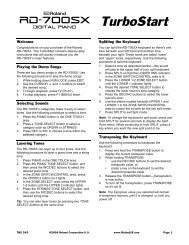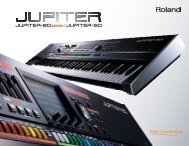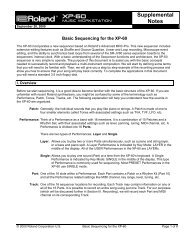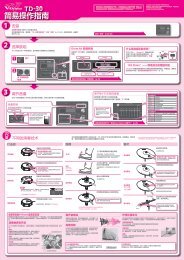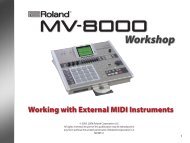Using the JUNO-STAGE with a Computer - Roland New Zealand
Using the JUNO-STAGE with a Computer - Roland New Zealand
Using the JUNO-STAGE with a Computer - Roland New Zealand
Create successful ePaper yourself
Turn your PDF publications into a flip-book with our unique Google optimized e-Paper software.
®ÂØÒňΠ®<br />
<strong>JUNO</strong>-<strong>STAGE</strong><br />
128-Voice Expandable Syn<strong>the</strong>sizer<br />
<strong>with</strong> Song Player<br />
Workshop<br />
<strong>Using</strong> <strong>the</strong> <strong>JUNO</strong>-<strong>STAGE</strong> <strong>with</strong> a <strong>Computer</strong><br />
© 2009 <strong>Roland</strong> Corporation U.S.<br />
All rights reserved. No part of this publication may be reproduced in any form <strong>with</strong>out <strong>the</strong><br />
written permission of <strong>Roland</strong> Corporation U.S.<br />
JSWS02<br />
1
About <strong>the</strong> Workshop Booklets<br />
<strong>Roland</strong>’s <strong>JUNO</strong> syn<strong>the</strong>sizers have been making history since <strong>the</strong> 1980s.<br />
They’ve always been affordable, easy to use, and sounded great. The<br />
<strong>JUNO</strong>-<strong>STAGE</strong> is designed specifically for performing, <strong>with</strong> everything you<br />
need on a gig at your fingertips. The <strong>JUNO</strong>-<strong>STAGE</strong>’s got 128-note polyphony<br />
and killer sounds derived from <strong>Roland</strong>’s acclaimed Fantom-X synths. Two SRX<br />
expansion slots allow you to add even more sounds from <strong>Roland</strong>’s huge SRX<br />
sound library. Split <strong>the</strong> keyboard or layer sounds quickly using dedicated<br />
buttons. Realtime controls let you shape <strong>JUNO</strong>-<strong>STAGE</strong> sounds as you play.<br />
Play along <strong>with</strong> audio files or SMFs stored on a USB flash drive, or connect a<br />
personal music player. Mix in, and add reverb to, a connected mic. Instantly<br />
configure <strong>the</strong> <strong>JUNO</strong>-<strong>STAGE</strong> as a MIDI controller of external MIDI devices or a<br />
computer-based DAW <strong>with</strong> a single button-press.<br />
This Workshop booklet is intended as a companion to <strong>the</strong> <strong>JUNO</strong>-<strong>STAGE</strong><br />
Owner’s Manual. It requires <strong>JUNO</strong>-<strong>STAGE</strong> Operating System v1.03 or higher.<br />
Download <strong>the</strong> latest <strong>JUNO</strong>-<strong>STAGE</strong> O.S. for free from www.<strong>Roland</strong>US.com.<br />
About This Booklet<br />
The <strong>JUNO</strong>-<strong>STAGE</strong> can exchange MIDI data <strong>with</strong> a Mac or PC via USB,<br />
letting you use <strong>the</strong> <strong>JUNO</strong>-<strong>STAGE</strong> as MIDI controller for a DAW and/or as a<br />
multitimbral sound module. It also allows you to create <strong>JUNO</strong>-<strong>STAGE</strong> sounds<br />
on your computer. This booklet explains how to get connected.<br />
Hot Links<br />
Each Workshop booklet is meant to be read in order from beginning<br />
to end. However, if we mention an upcoming section—and you see<br />
this arrow—you can click <strong>the</strong> arrow to jump <strong>the</strong>re immediately.<br />
Things You Can Do <strong>with</strong> Your MIDI Connection<br />
Though you might think <strong>the</strong> <strong>JUNO</strong>-<strong>STAGE</strong>’s Playlist Editor software<br />
somehow involves MIDI communication, it doesn’t—all you need to use<br />
it is a <strong>JUNO</strong>-<strong>STAGE</strong>-formatted USB stick you can plug first into your<br />
computer, and <strong>the</strong>n into your <strong>JUNO</strong>-<strong>STAGE</strong>.<br />
In this booklet, we’re going to assume you know how to operate your<br />
computer. If you don’t, consult its documentation before proceeding.<br />
Edit and Create <strong>JUNO</strong>-<strong>STAGE</strong> Sounds<br />
This <strong>JUNO</strong>-<strong>STAGE</strong>’s streamlined front panel conceals <strong>the</strong> many possibilities<br />
of <strong>the</strong> <strong>JUNO</strong>-<strong>STAGE</strong>’s sound engine. The <strong>JUNO</strong>-<strong>STAGE</strong> Editor software allows<br />
you to unlock this power. The accompanying Librarian software helps you<br />
store and keep track of all of your <strong>JUNO</strong>-<strong>STAGE</strong> sounds and performances.<br />
Understanding <strong>the</strong> Symbols in This Booklet<br />
Throughout this booklet, you’ll come across information that deserves<br />
special attention—that’s why it’s labeled <strong>with</strong> one of <strong>the</strong> following symbols.<br />
Current settings...<br />
...go to <strong>the</strong> <strong>JUNO</strong>-<strong>STAGE</strong>.<br />
U<br />
SB<br />
A note is something that adds information about <strong>the</strong> topic at hand.<br />
A tip offers suggestions for using <strong>the</strong> feature being discussed.<br />
U<br />
SB<br />
...are sent to <strong>the</strong> software.<br />
Your edited settings...<br />
Warnings contain important information that can help you avoid<br />
possible damage to your equipment, your data, or yourself.<br />
2
Use <strong>the</strong> <strong>JUNO</strong>-<strong>STAGE</strong> <strong>with</strong> a DAW<br />
MIDI notes...<br />
...where <strong>the</strong>y play notes.<br />
You can use a GM2 System On message contained in an SMF file to<br />
select <strong>the</strong> <strong>JUNO</strong>-<strong>STAGE</strong>’s General MIDI 2 sounds, or you can press <strong>the</strong><br />
<strong>JUNO</strong>-<strong>STAGE</strong>’s PERFORM button and select PRST 033 GM2 Template.<br />
U<br />
SB<br />
Setting Up Your <strong>Computer</strong> for <strong>the</strong> <strong>JUNO</strong>-<strong>STAGE</strong><br />
U<br />
SB<br />
...are captured in <strong>the</strong> DAW.<br />
Notes go to <strong>JUNO</strong>-<strong>STAGE</strong>...<br />
Installing <strong>the</strong> <strong>JUNO</strong>-<strong>STAGE</strong> Software on Your <strong>Computer</strong><br />
The <strong>JUNO</strong>-<strong>STAGE</strong> works <strong>with</strong> <strong>the</strong> following operating systems:<br />
• Windows XP • Windows Vista 32-bit Edition • Mac OS X<br />
In this booklet we’ll describe <strong>the</strong> Windows XP, Vista, and Mac OS X installation<br />
of <strong>the</strong> <strong>JUNO</strong>-<strong>STAGE</strong>’s USB MIDI driver, Editor/Librarian, and Playlist Editor.<br />
With its light weight and its ability to run on battery power, <strong>the</strong> <strong>JUNO</strong>-<strong>STAGE</strong><br />
makes an excellent portable MIDI controller for a DAW, especially a laptop<br />
DAW. By plugging earbuds or headphones into your computer, you can<br />
use a DAW’s soft synths; plugging <strong>the</strong>m into <strong>the</strong> <strong>JUNO</strong>-<strong>STAGE</strong> lets you use<br />
<strong>JUNO</strong>-<strong>STAGE</strong> sounds. In a more complex setup, listen to both through an<br />
audio interface.<br />
Play General MIDI2 SMFs from a <strong>Computer</strong><br />
If you have a program<br />
on your computer<br />
that plays General<br />
MIDI or General MIDI2<br />
SMFs (“Standard MIDI<br />
Files”), you can play<br />
<strong>the</strong>m using <strong>the</strong> <strong>JUNO</strong>-<br />
<strong>STAGE</strong>’s built-in GM2<br />
sounds.<br />
U<br />
SB<br />
When you connect <strong>the</strong> <strong>JUNO</strong>-<strong>STAGE</strong> to your computer via USB, you’ll<br />
typically get <strong>the</strong> best results using USB jacks on <strong>the</strong> back of a desktop<br />
computer or on <strong>the</strong> side of a laptop. We recommend not using a hub.<br />
You’ll find <strong>the</strong> <strong>JUNO</strong>-<strong>STAGE</strong> software on <strong>the</strong> CD-ROM that came <strong>with</strong> your<br />
<strong>JUNO</strong>-<strong>STAGE</strong>. If you’re using<br />
• Windows XP— you’ll find <strong>the</strong> driver in <strong>the</strong> XP folder <strong>with</strong>in <strong>the</strong> CD-ROM’s<br />
root-level Driver folder. You’ll find <strong>the</strong> Editor/Librarian installer in <strong>the</strong><br />
root-level Editor folder, and <strong>the</strong> Playlist Editor in <strong>the</strong> root-level Playlist<br />
Editor folder.<br />
• Vista— you’ll find <strong>the</strong> driver in <strong>the</strong> Vista folder <strong>with</strong>in <strong>the</strong> CD-ROM’s<br />
root-level Driver folder. You’ll find <strong>the</strong> Editor/Librarian installer in <strong>the</strong><br />
root-level Editor folder, and <strong>the</strong> Playlist Editor in <strong>the</strong> root-level Playlist<br />
Editor folder.<br />
• Mac OS X— you’ll find <strong>the</strong> driver installer in <strong>the</strong> CD-ROM’s root-level<br />
Driver folder, <strong>the</strong> Editor installer in <strong>the</strong> root-level Editor folder, and <strong>the</strong><br />
Playlist Editor installer in <strong>the</strong> root-level Editor folder.<br />
The Downloads tab at http://www.rolandus.com/products/<br />
productdetails.php?ProductId=967 has <strong>the</strong> latest <strong>JUNO</strong>-<strong>STAGE</strong><br />
software.<br />
3
Windows XP<br />
Installing <strong>the</strong> <strong>JUNO</strong>-<strong>STAGE</strong> USB MIDI Driver<br />
1 Power up your PC <strong>with</strong> all USB cables disconnected except for your<br />
keyboard and mouse. If any applications are running, quit <strong>the</strong>m.<br />
2 Open up <strong>the</strong> XP Drivers folder, and <strong>the</strong>n double-click <strong>the</strong> Setup file<br />
inside to display <strong>the</strong> following window:<br />
4<br />
If you see <strong>the</strong> Software Installation window instead of<br />
<strong>the</strong> one shown above, click Continue Anyway. If you can’t<br />
continue, see “About Driver Signing Options” later in this<br />
booklet. (You can click this button to jump <strong>the</strong>re now.)<br />
Click Next—<strong>the</strong> driver is installed and instructions appear telling you<br />
what to do next.<br />
3<br />
If XP asks if you want to run this file, click Run. If an “Install Program<br />
as O<strong>the</strong>r User” dialog appears, quit <strong>the</strong> installer, and <strong>the</strong>n log in as <strong>the</strong><br />
system administrator before re-launching <strong>the</strong> Setup application.<br />
Click Next to display <strong>the</strong> installation start window:<br />
5<br />
6<br />
We’ll take you through <strong>the</strong>se instructions in this booklet, so you can<br />
close this window, or drag it over to <strong>the</strong> side of <strong>the</strong> screen if you want<br />
to keep it open.<br />
With <strong>the</strong> <strong>JUNO</strong>-<strong>STAGE</strong>’s power turned off, plug one end of <strong>the</strong><br />
included USB cable into its USB jack, and <strong>the</strong> o<strong>the</strong>r end into <strong>the</strong> USB<br />
jack you want to use on your computer.<br />
Turn on <strong>the</strong> <strong>JUNO</strong>-<strong>STAGE</strong>—after a few moments, <strong>the</strong> PC’s Found<br />
<strong>New</strong> Hardware Wizard window appears, as shown in <strong>the</strong> following<br />
screenshot.<br />
If, instead of seeing <strong>the</strong> Found <strong>New</strong> Hardware window, you’re asked if<br />
you want to connect to Windows Update, select No, not this time, and<br />
<strong>the</strong>n click Next to display <strong>the</strong> Found <strong>New</strong> Hardware window.<br />
4
About Driver Signing Options<br />
The Driver Signing window lets you select whe<strong>the</strong>r Windows should block<br />
<strong>the</strong> installation of an unknown driver, warn you about it, or just install it.<br />
1<br />
2<br />
In <strong>the</strong> Start menu, select Control Panel.<br />
If you’re in<br />
• Category View— click Performance and Maintenance, and <strong>the</strong>n<br />
click System.<br />
• Classic View— double-click System.<br />
7<br />
Click <strong>the</strong> button to <strong>the</strong> left of “Install <strong>the</strong> software automatically<br />
(Recommended),” and <strong>the</strong>n click Next to install <strong>the</strong> driver.<br />
When <strong>the</strong> driver’s installed, <strong>the</strong> wizard announces <strong>the</strong> completion of<br />
<strong>the</strong> installation process.<br />
If <strong>the</strong> “Software installation” window appears after you click Next,<br />
click Continue Anyway. If you can’t continue, see “About Driver Signing<br />
Options” to <strong>the</strong> right of this page.<br />
8<br />
If <strong>the</strong> “System Settings Change” window appears, click Yes to restart<br />
Windows.<br />
Click Finish.<br />
Windows displays “Your new hardware is ready to use.”<br />
9 If <strong>the</strong> Driver Setup window’s still open, click its Close button.<br />
10 Restart your computer.<br />
3<br />
Click <strong>the</strong> Hardware tab, and <strong>the</strong>n click Driver Signing.<br />
4 Set “What action do you want Windows to take?” to Ignore or Warn.<br />
5<br />
Click OK to close <strong>the</strong> Driver Signing window.<br />
Should you ever need to remove <strong>the</strong> <strong>JUNO</strong>-<strong>STAGE</strong> driver from your<br />
system, its installer folder contains an uninstaller. You can hold onto<br />
this file, or re-download <strong>the</strong> driver folder later should you need it.<br />
Later in this booklet, we’ll provide some fur<strong>the</strong>r information<br />
on using <strong>the</strong> <strong>JUNO</strong>-<strong>STAGE</strong> <strong>with</strong> a DAW. Click <strong>the</strong> button here<br />
to jump to this section now if you like.<br />
6<br />
7<br />
Click OK to close <strong>the</strong> System Properties window.<br />
Return to <strong>the</strong> driver installation instructions earlier in this booklet.<br />
5
Installing <strong>the</strong> Editor/Librarian and Playlist Editor<br />
You can install both <strong>the</strong> <strong>JUNO</strong>-<strong>STAGE</strong> Editor/Librarian software and <strong>the</strong><br />
Playlist Editor software in a single operation. Here’s how to do this.<br />
1<br />
Double-click <strong>the</strong> <strong>JUNO</strong>-<strong>STAGE</strong> Editor Setup executable<br />
file. The installer opens. (If XP asks if you want to run this<br />
file, click Run.)<br />
6<br />
Checkmark both <strong>the</strong> <strong>JUNO</strong>-<strong>STAGE</strong> Editor and <strong>the</strong> <strong>JUNO</strong>-<strong>STAGE</strong><br />
Librarian software—if <strong>the</strong>y’re not already checked—and <strong>the</strong>n click<br />
Next.<br />
If you want to install only one of <strong>the</strong> <strong>JUNO</strong>-<strong>STAGE</strong> programs, make sure<br />
it’s <strong>the</strong> only one that’s checked in this window.<br />
2<br />
3<br />
4<br />
Click Next.<br />
Read <strong>the</strong> License Agreement, and if you’d like to proceed <strong>with</strong> <strong>the</strong><br />
installation, click Yes.<br />
In <strong>the</strong> Choose Destination Location window, you can select a<br />
location on your hard drive for <strong>the</strong> <strong>JUNO</strong>-<strong>STAGE</strong> software—if you<br />
don’t have a specific reason to choose a different location, leave <strong>the</strong><br />
default location as is—and <strong>the</strong>n click Next to display <strong>the</strong> Setup Type<br />
window.<br />
7<br />
8<br />
Vista<br />
The installer displays your installation selections and tells you it’s now<br />
ready to install <strong>the</strong> <strong>JUNO</strong>-<strong>STAGE</strong> software. Click Next to proceed—<strong>the</strong><br />
files are installed.<br />
Click Finish to exit <strong>the</strong> installer.<br />
Installing <strong>the</strong> <strong>JUNO</strong>-<strong>STAGE</strong> USB MIDI Driver<br />
1 Power up your PC <strong>with</strong> all USB cables disconnected except for your<br />
keyboard and mouse. If any applications are running, quit <strong>the</strong>m.<br />
2 Open up <strong>the</strong> Vista Drivers folder, and double-click <strong>the</strong> Setup file<br />
inside.<br />
If Vista tells you a program needs your permission to continue, click<br />
Continue.<br />
5<br />
Highlight <strong>the</strong> Custom installation, and <strong>the</strong>n click Next.<br />
6
3<br />
The Driver Setup window appears:<br />
4<br />
5<br />
Click Next to display <strong>the</strong> Driver Setup instructions window:<br />
Click Next.<br />
We’ll take you through <strong>the</strong>se instructions in this booklet, so you can<br />
close this window, or drag it over to <strong>the</strong> side of <strong>the</strong> screen if you want<br />
to keep it open.<br />
7 With <strong>the</strong> <strong>JUNO</strong>-<strong>STAGE</strong>’s power turned off, plug one end of <strong>the</strong><br />
included USB cable into its USB jack, and <strong>the</strong> o<strong>the</strong>r end into <strong>the</strong> USB<br />
jack you want to use on your computer.<br />
8 Turn on <strong>the</strong> <strong>JUNO</strong>-<strong>STAGE</strong>—after a few moments, “Installing device<br />
driver software” appears in <strong>the</strong> lower right corner of <strong>the</strong> screen.<br />
9 When <strong>the</strong> PC’s finished installing <strong>the</strong> driver, “<strong>JUNO</strong> Series Device<br />
driver software installed successfully” appears onscreen.<br />
10 Restart your computer.<br />
Later in this booklet, we’ll provide some fur<strong>the</strong>r information<br />
on using <strong>the</strong> <strong>JUNO</strong>-<strong>STAGE</strong> <strong>with</strong> a DAW. Click <strong>the</strong> button here<br />
to jump to this section now if you like.<br />
6<br />
If Windows Security asks if you’d like to install this device software—<br />
as shown above—click Install.<br />
The driver’s installed, and a window opens <strong>with</strong> instructions.<br />
Installing <strong>the</strong> Editor/Librarian and Playlist Editor<br />
You can install both <strong>the</strong> <strong>JUNO</strong>-<strong>STAGE</strong> Editor/Librarian software<br />
and <strong>the</strong> Playlist Editor software in a single operation. Here’s<br />
how to do this.<br />
1<br />
Double-click <strong>the</strong> <strong>JUNO</strong>-<strong>STAGE</strong> Editor Setup executable<br />
file. The installer opens.<br />
If Vista tells you a program needs your permission to continue, click<br />
Continue.<br />
7
Mac OS X<br />
Installing <strong>the</strong> <strong>JUNO</strong>-<strong>STAGE</strong> USB MIDI Driver<br />
The <strong>JUNO</strong>-<strong>STAGE</strong> USB MIDI driver is compatible <strong>with</strong> Mac OS X 10.3.9<br />
and higher. It’ll work on any Mac <strong>with</strong> an Intel processor or PowerPC<br />
G4 or G5.<br />
2<br />
3<br />
Click Next, read <strong>the</strong> License Agreement, and if you’d like to proceed<br />
<strong>with</strong> <strong>the</strong> installation, click Yes.<br />
In <strong>the</strong> Choose Destination Location window, you can select a location<br />
on your hard drive for <strong>the</strong> <strong>JUNO</strong>-<strong>STAGE</strong> software—unless you have<br />
a reason to choose a different location, leave <strong>the</strong> default location as<br />
is—and <strong>the</strong>n click Next to display <strong>the</strong> Setup Type window.<br />
1<br />
2<br />
3<br />
Disconnect all USB cables from your computer except for your<br />
keyboard and mouse.<br />
Open <strong>the</strong> Driver folder on <strong>the</strong> <strong>JUNO</strong>-<strong>STAGE</strong> CD-ROM and double-click<br />
<strong>the</strong> <strong>JUNO</strong>SeriesUSBDriver.pkg file.<br />
If <strong>the</strong> installer says it needs to run a program to determine if <strong>the</strong><br />
driver can be installed, click Continue.<br />
4<br />
Highlight <strong>the</strong> Custom installation, and <strong>the</strong>n click Next.<br />
The <strong>Roland</strong> <strong>JUNO</strong> Series Driver Ver.X.X.X for Mac OS X window<br />
appears.<br />
5<br />
Checkmark both <strong>the</strong> <strong>JUNO</strong>-<strong>STAGE</strong> Editor and <strong>the</strong> Librarian software—<br />
if <strong>the</strong>y’re not already checked—and <strong>the</strong>n click Next.<br />
6<br />
7<br />
If you want to install only one of <strong>the</strong> <strong>JUNO</strong>-<strong>STAGE</strong> programs, make sure<br />
it’s <strong>the</strong> only one that’s checked in this window.<br />
When <strong>the</strong> installer displays your installation selections, click Next to<br />
proceed—in a few moments, <strong>the</strong> files are installed.<br />
Click Finish to exit <strong>the</strong> installer.<br />
4<br />
Click Continue to display <strong>the</strong> Installation Type window, shown on <strong>the</strong><br />
next page.<br />
8
9<br />
When you see <strong>the</strong> Install Succeeded window, click Restart.<br />
We recommend using <strong>the</strong> default install location unless you’ve got<br />
a specific reason for not doing so. If you do, click Change Install<br />
Location... and <strong>the</strong>n choose <strong>the</strong> location you want.<br />
If your Mac displays a message about reboot caches, click OK.<br />
If your Mac has more than a single hard drive or volume, you may be<br />
asked to select <strong>the</strong> drive on which you want to install <strong>the</strong> driver. Select<br />
<strong>the</strong> drive <strong>with</strong> your active operating system on it.<br />
When <strong>the</strong> Mac’s restarted, make sure <strong>the</strong> <strong>JUNO</strong>-<strong>STAGE</strong>’s power is<br />
turned off, plug one end of your USB cable into <strong>the</strong> <strong>JUNO</strong>-<strong>STAGE</strong>’s rearpanel<br />
USB jack, plug <strong>the</strong> o<strong>the</strong>r end into <strong>the</strong> USB jack you want to use<br />
on your computer, and <strong>the</strong>n turn on <strong>the</strong> <strong>JUNO</strong>-<strong>STAGE</strong>.<br />
5<br />
Click Install to display <strong>the</strong> password au<strong>the</strong>ntication window. Most<br />
likely, your user name will already be filled in.<br />
Whenever you perform Mac OS X system updates, please disconnect<br />
<strong>the</strong> <strong>JUNO</strong>-<strong>STAGE</strong> during <strong>the</strong> process to avoid having to reinstall <strong>the</strong><br />
<strong>JUNO</strong>-<strong>STAGE</strong> USB MIDI driver.<br />
6<br />
7<br />
Type an administrator password for your computer.<br />
Click OK—<strong>the</strong> installer informs you that a restart of your computer<br />
will be required after <strong>the</strong> driver’s installed.<br />
In <strong>the</strong> same folder as <strong>the</strong> <strong>JUNO</strong>SeriesUSBDriver.pkg file you’ll find <strong>the</strong><br />
<strong>JUNO</strong>Series Uninstaller. You can hold onto this file, or re-download <strong>the</strong><br />
driver folder later should you need it.<br />
Later in this booklet, we’ll provide some fur<strong>the</strong>r information<br />
on using <strong>the</strong> <strong>JUNO</strong>-<strong>STAGE</strong> <strong>with</strong> a DAW. Click <strong>the</strong> button here<br />
to jump to this section now if you like.<br />
8<br />
Click Continue Installation to install <strong>the</strong> <strong>JUNO</strong>-<strong>STAGE</strong> USB MIDI<br />
driver.<br />
9
Installing <strong>the</strong> Editor/Librarian and Playlist Editor<br />
About <strong>Using</strong> <strong>the</strong> <strong>JUNO</strong>-<strong>STAGE</strong> <strong>with</strong> a DAW<br />
The procedures for installing both <strong>the</strong> <strong>JUNO</strong>-<strong>STAGE</strong> Editor/Librarian<br />
software and <strong>the</strong> Playlist Editor software are identical. The two<br />
programs must be installed separately, and no restart is required after<br />
ei<strong>the</strong>r installation.<br />
The Editor/Librarian and Playlist Editor come <strong>with</strong> <strong>the</strong>ir own<br />
documentation, so we’re just going to discuss <strong>the</strong>ir installation here.<br />
Setting Up MIDI Communication<br />
<strong>Using</strong> <strong>the</strong> <strong>JUNO</strong>-<strong>STAGE</strong> as a MIDI Controller Only<br />
The <strong>JUNO</strong>-<strong>STAGE</strong>’s MIDI Controller mode makes it simple to configure <strong>the</strong><br />
<strong>JUNO</strong>-<strong>STAGE</strong> for use <strong>with</strong> a DAW. Press <strong>the</strong> <strong>JUNO</strong>-<strong>STAGE</strong>’s MIDI CONTROLLER<br />
button to light it and display <strong>the</strong> MIDI CONTROLLER screen.<br />
1<br />
2<br />
3<br />
In <strong>the</strong> Editor folder, double-click <strong>the</strong> <strong>JUNO</strong>-<strong>STAGE</strong> Editor Installer.<br />
mpkg or <strong>the</strong> Playlist Editor file—<strong>the</strong> installer window appears.<br />
Click Continue.<br />
At <strong>the</strong> Software License Agreement window, click Continue, and <strong>the</strong>n<br />
click Agree when <strong>the</strong> licensing sheet comes down. (If you want to<br />
read <strong>the</strong> agreement first, click Read License.)<br />
Most DAWs “re-channelize” <strong>the</strong> incoming data to <strong>the</strong> desired MIDI track,<br />
so <strong>the</strong>re’s seldom a need to match <strong>the</strong> <strong>JUNO</strong>-<strong>STAGE</strong>’s transmit channel to<br />
<strong>the</strong> DAW’s MIDI receiving channel. However, if you do need to do this, this<br />
is where you can see and set <strong>the</strong> <strong>JUNO</strong>-<strong>STAGE</strong>’s transmit channel for MIDI<br />
Controller mode—<strong>the</strong> MIDI Ch parameter is selected in <strong>the</strong> picture above.<br />
4<br />
5<br />
6<br />
In <strong>the</strong> Installation Type window, click Install unless you want to<br />
change <strong>the</strong> installation location for some reason.<br />
In <strong>the</strong> password au<strong>the</strong>ntication window, enter your password—<strong>the</strong><br />
Editor/Librarian or Playlist Editor is installed.<br />
When “Install Succeeded” appears, click Close to exit <strong>the</strong> installer.<br />
The programs you’ve installed can be found in <strong>the</strong> <strong>Roland</strong> folder <strong>with</strong>in<br />
your Applications folder, presuming you didn’t change <strong>the</strong>ir destination<br />
location during installation. The Editor and Librarian programs are<br />
located in <strong>the</strong> <strong>JUNO</strong>-<strong>STAGE</strong> Editor folder. The Playlist Editor’s in its<br />
own folder.<br />
The Local Sw determines whe<strong>the</strong>r or not <strong>the</strong> current <strong>JUNO</strong>-<strong>STAGE</strong> sound<br />
plays in MIDI Controller mode. When you’re sequencing you’ll want to leave<br />
this set to Off so notes you play go only to <strong>the</strong> DAW. This is because<br />
• you don’t want to hear doubled notes— when a DAW track’s MIDI output is<br />
being sent back to <strong>the</strong> <strong>JUNO</strong>-<strong>STAGE</strong>, each note would sound once when<br />
you struck a key, and <strong>the</strong>n again when <strong>the</strong> data had passed through <strong>the</strong><br />
DAW and back to <strong>the</strong> <strong>JUNO</strong>-<strong>STAGE</strong> (this is called a “MIDI loop”).<br />
• you want to hear what you’re actually sequencing— when you’re<br />
sequencing <strong>with</strong> DAW soft synths. If you’re also hearing a <strong>JUNO</strong>-<strong>STAGE</strong><br />
sound as you sequence, what you hear is not so much what you get.<br />
When you’re using MIDI Controller mode to control external MIDI sound<br />
modules, you may want to turn Local Sw on to combine <strong>JUNO</strong>-<strong>STAGE</strong><br />
sounds <strong>with</strong> those from your external modules.<br />
The MIDI CONTROLLER screen offers some o<strong>the</strong>r interesting tools,<br />
explained on Page 89 of <strong>the</strong> <strong>JUNO</strong>-<strong>STAGE</strong> Owner’s Manual.<br />
10
<strong>Using</strong> <strong>the</strong> <strong>JUNO</strong>-<strong>STAGE</strong> as a Controller and<br />
Sound Module<br />
Piano<br />
MIDI<br />
Channel 1<br />
Part 1—GM 001 PIANO 001<br />
You can use <strong>the</strong> <strong>JUNO</strong>-<strong>STAGE</strong>’s keyboard as a MIDI controller for a DAW<br />
whose tracks are playing <strong>JUNO</strong>-<strong>STAGE</strong> sounds. Here’s how to set this up:<br />
1<br />
Press <strong>the</strong> <strong>JUNO</strong>-<strong>STAGE</strong>’s MENU button.<br />
Bass<br />
Drums<br />
MIDI<br />
Channel 2<br />
MIDI<br />
Channel 10<br />
Part 2—GM 079 Fingered Bs<br />
Part 10—GM 001 STANDARD<br />
DAW tracks<br />
<strong>JUNO</strong>-<strong>STAGE</strong> performance parts<br />
2<br />
Press ENTER to display <strong>the</strong> first system screen.<br />
The performance’s parts are also set to respond to various MIDI<br />
Program Change, Bank Select, and Control Change messages. All<br />
of <strong>the</strong> parts are also set to default levels you can change <strong>with</strong> MIDI<br />
messages from <strong>the</strong> DAW.<br />
3<br />
Press F3 (MIDI/SYNC) to display <strong>the</strong> MIDI screen.<br />
To learn about MIDI Program Change, Bank Select, and Control Change<br />
messages, see our An Introduction to MIDI InFocus booklet. To learn<br />
how to work <strong>with</strong> <strong>the</strong>m in your DAW, see your DAW’s documentation.<br />
4 Set Local Switch to Off. (For an explanation of why you should do<br />
this, see <strong>the</strong> above explanation of MIDI Controller mode’s Local Sw<br />
parameter.)<br />
5 Press F6 (WRITE) to save <strong>the</strong> change you’ve made.<br />
6 Press <strong>the</strong> PERFORM button and select PRST 033 GM2 Template. This<br />
performance sets up <strong>the</strong> <strong>JUNO</strong>-<strong>STAGE</strong> for use as multitimbral sound<br />
module, and allows you to play up to 16 separate <strong>JUNO</strong>-<strong>STAGE</strong><br />
sounds from your DAW.<br />
In this performance, <strong>the</strong> 16 parts are lined up <strong>with</strong> <strong>the</strong> 16 MIDI<br />
channels so that Parts 1-16 receive MIDI data on MIDI Channels 1-16,<br />
respectively. Each DAW track sends out data on <strong>the</strong> MIDI channel<br />
corresponding to <strong>the</strong> part that plays its sound.<br />
7<br />
You’re now set up.<br />
As you sequence tracks, <strong>the</strong>re’s nothing you need to do on <strong>the</strong> <strong>JUNO</strong>-<br />
<strong>STAGE</strong> o<strong>the</strong>r than play. Everything else takes place in <strong>the</strong> DAW.<br />
About Selecting <strong>JUNO</strong>-<strong>STAGE</strong> Sounds for Use <strong>with</strong> a DAW<br />
No matter how you decide to select sounds for use <strong>with</strong> a DAW, we<br />
recommend starting <strong>with</strong> PRST 033 GM2 Template.<br />
When you’re playing <strong>JUNO</strong>-<strong>STAGE</strong> sounds from a DAW, <strong>the</strong>re are three ways<br />
to select <strong>the</strong> sounds in <strong>the</strong> <strong>JUNO</strong>-<strong>STAGE</strong> performance you use.<br />
• You can create a performance <strong>with</strong> <strong>the</strong> desired sounds on <strong>the</strong><br />
<strong>JUNO</strong>-<strong>STAGE</strong>—Here’s how:<br />
1<br />
With your performance selected, press <strong>the</strong> PART<br />
SELECT button.<br />
11
2 Select each part using <strong>the</strong> parameter circled in <strong>the</strong> previous<br />
screenshot.<br />
3 Select <strong>the</strong> desired sound for <strong>the</strong> part.<br />
• You can build <strong>the</strong> performance you want using <strong>the</strong> <strong>JUNO</strong>-<strong>STAGE</strong> Editor—<br />
on your computer, and <strong>the</strong>n send it to <strong>the</strong> <strong>JUNO</strong>-<strong>STAGE</strong>’s memory.<br />
To preserve performances you create using ei<strong>the</strong>r method, write <strong>the</strong>m<br />
into <strong>the</strong> <strong>JUNO</strong>-<strong>STAGE</strong>’s memory. See Page 133 in <strong>the</strong> Owner’s Manual.<br />
• The DAW tracks can select each part’s sound— by sending MIDI Bank<br />
Select and Program Change messages to <strong>the</strong> <strong>JUNO</strong>-<strong>STAGE</strong> on <strong>the</strong> part’s<br />
MIDI channel.<br />
Configuring Your DAW for Use <strong>with</strong> <strong>the</strong> <strong>JUNO</strong>-<strong>STAGE</strong><br />
Once you’ve installed <strong>the</strong> <strong>JUNO</strong>-<strong>STAGE</strong> driver and made your USB connection,<br />
your software DAW can<br />
• receive MIDI data from <strong>the</strong> <strong>JUNO</strong>-<strong>STAGE</strong>— This allows you to play <strong>the</strong><br />
DAW’s soft synths, and to sequence your playing onto DAW tracks.<br />
• use <strong>the</strong> <strong>JUNO</strong>-<strong>STAGE</strong> as a destination for outgoing MIDI data— This allows<br />
<strong>the</strong> DAW to play <strong>the</strong> <strong>JUNO</strong>-<strong>STAGE</strong>’s sounds from its tracks.<br />
While each DAW has its own way of doing things, some general principles<br />
always apply. (You can consult your software’s documentation for details.)<br />
If<br />
• you’ve selected a performance on <strong>the</strong> <strong>JUNO</strong>-<strong>STAGE</strong> so you can sequence<br />
using multiple <strong>JUNO</strong>-<strong>STAGE</strong> sounds—each of <strong>the</strong> performance’s parts<br />
transmits on its same-numbered MIDI channel. From <strong>the</strong> PERFORM<br />
PLAY screen, press F6 (PARTVIEW), and <strong>the</strong>n use <strong>the</strong> 6 and 5 buttons<br />
to move from part to part. The <strong>JUNO</strong>-<strong>STAGE</strong> will transmit MIDI data on<br />
<strong>the</strong> currently selected part’s channel.<br />
• you haven’t selected a performance on <strong>the</strong> <strong>JUNO</strong>-<strong>STAGE</strong>— you can set<br />
<strong>the</strong> Kbd Patch Tx/Rx Channel parameter to <strong>the</strong> desired channel. To get<br />
to <strong>the</strong> parameter, follow <strong>the</strong> instructions on Page 11 of this booklet to<br />
navigate to <strong>the</strong> System MIDI screen.<br />
Sending Data from DAW Tracks to <strong>the</strong> <strong>JUNO</strong>-<strong>STAGE</strong><br />
All DAWs provide a method for directing sequenced MIDI data from<br />
individual MIDI tracks to <strong>the</strong> desired external devices—for example, <strong>the</strong><br />
parts of a <strong>JUNO</strong>-<strong>STAGE</strong> performance. Consult your DAW’s documentation to<br />
learn how to direct <strong>the</strong> data on each of your DAW’s MIDI tracks to <strong>the</strong> desired<br />
<strong>JUNO</strong>-<strong>STAGE</strong> parts.<br />
The End<br />
We hope you’ve found this workshop helpful. Keep an eye out for new<br />
<strong>JUNO</strong>-<strong>STAGE</strong> updates and support documents you can download for free at<br />
www.<strong>Roland</strong>US.com.<br />
Receiving <strong>JUNO</strong>-<strong>STAGE</strong> MIDI Data in a DAW<br />
To get your DAW to receive MIDI data from <strong>the</strong> <strong>JUNO</strong>-<strong>STAGE</strong>, select <strong>the</strong><br />
<strong>JUNO</strong>-<strong>STAGE</strong> as a MIDI input <strong>with</strong>in <strong>the</strong> DAW, or set <strong>the</strong> DAW to receive all<br />
MIDI data coming into <strong>the</strong> computer. If your DAW can accept MIDI data on all<br />
MIDI channels—often referred to as “omni” mode—enable this option.<br />
As we mentioned earlier, <strong>the</strong>re’s seldom a need to match <strong>the</strong> DAW’s<br />
incoming MIDI channel to <strong>the</strong> <strong>JUNO</strong>-<strong>STAGE</strong>’s transmit channel. However, if<br />
you need to do this, here’s how to figure out and/or set <strong>the</strong> <strong>JUNO</strong>-<strong>STAGE</strong>’s<br />
MIDI transmit—shown as “Tx” onscreen—channel when you’re not in MIDI<br />
Controller mode.<br />
12


